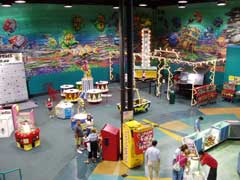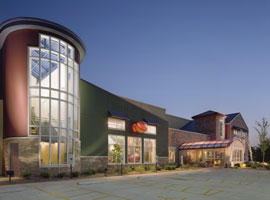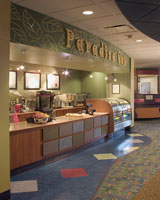
Vol. IV, No. 8, August 2004
- Editor's Corner
- Mothers and Leisure Time
- We've Been in the News
- Beware of Suppliers Promising Plenty
- What's Happening with Children's Edutainment?
- Pal's Sudden Service Drive-Through
- Putt-Putt Celebrates its 50th Anniversary
- Construction Material Price Increases Impact New LBEs
- Families Grab Large Restaurant Market Share
- Kids' Menus Under Major Revision
- Playdate Lawyers
- Get $30 in Books for FREE!
- Cheese Price Increases Impact Profitability
- Busy Dog Days of Summer
- 2005 Educational Seminar Dates Announced
Editor's Corner
Observations on carnivals in warehouses

Typical carnival in a warehouse
As I travel around the country, I continue to be amazed by the entertainment centers many entrepreneurs continue to develop that are totally out of sync with the markets they are attempting to serve. At the last month's Foundations Entertainment University, I described those centers to attendees as "carnivals in a warehouse with an outdoor concrete desert." Yes, that's exactly how I would describe many of the centers I see. For some reason, many center developers seem totally oblivious to the socio-economics of their potential customers. They must think the entertainment attractions, games, rides and other features alone constitute the entire guest experience. They don't understand that the design of the facility, its décor and ambiance, lighting, acoustics, landscaping and food -- as well as the staff's appearance and interaction with guests -- are all essential to crafting an experience that creates value and makes guests want to return and return and return. The entertainment attractions are only one part of the overall experience.
Today's customers, as a rule, are rather sophisticated and expect to be offered quality. This holds true whether they're in a fast food restaurant, fast casual or fine dining restaurant, retail store, hotel, airport, cruise ship, mall -- the list is endless. Yet many location-based entertainment (LBE) owners obviously think LBEs are somehow exempt from the need to offer quality -- that a carnival in a warehouse will still attract today's sophisticated, upscale customers.
We're seeing LBE Darwinism take its toll on such facilities, which are closing or being sold off for other uses. Unfortunately, many millions of dollars are being lost in the process. Some facilities are actually being recycled into different types of LBEs that match the expectations of today's customers. We are working for a church that has purchased a failed water park/FEC (family entertainment center) and will redevelop it as a new church campus. This particular project is located in a densely populated, upscale, suburban market with a high concentration of families with children. The average family income is $123,000, and the number of college-degreed adults is double the U.S. average. The facility is located along a major, high-traffic road with good access and basically no competition. Yet this LBE failed. Why? We see the root cause as the facility's total mismatch to its market. For example, the warehouse-style building has nonexistent finishes indoors and out. At best, it might have appealed to a more blue-collar market, but it was a total mismatch to its upscale market environs.
The go-kart track will be razed. The water park will be demolished. The building will be totally renovated and become the church. And part of the property will be redeveloped as a state-of-the-art, upscale children's edutainment center open to the public as part of the church's evangelical program.
We know of another indoor 50,000-square-foot FEC in a thriving white-collar, suburban market at a good location that was also a warehouse finish -- and it also failed. It, too, is being purchased by a church to be renovated.
Great locations in great markets do not equal success. They are only the first two ingredients. Next comes matching the guest experience to the market, which requires many other ingredients - not just entertainment attractions. You can't meet the increasingly sophisticated expectations of today's consumers by doing an LBE on the cheap as yet another carnival in a warehouse. Developing successful LBEs is not a task for amateurs, and it takes considerable financial investment to get it right.
Randy White
Editor


Paradise Park Family Entertainment & Children's Edutainment Center
was designed by
the White Hutchinson Leisure & Learning Group to appeal to its upscale
market.
Vol. IV, No. 8, August 2004
- Editor's Corner
- Mothers and Leisure Time
- We've Been in the News
- Beware of Suppliers Promising Plenty
- What's Happening with Children's Edutainment?
- Pal's Sudden Service Drive-Through
- Putt-Putt Celebrates its 50th Anniversary
- Construction Material Price Increases Impact New LBEs
- Families Grab Large Restaurant Market Share
- Kids' Menus Under Major Revision
- Playdate Lawyers
- Get $30 in Books for FREE!
- Cheese Price Increases Impact Profitability
- Busy Dog Days of Summer
- 2005 Educational Seminar Dates Announced


